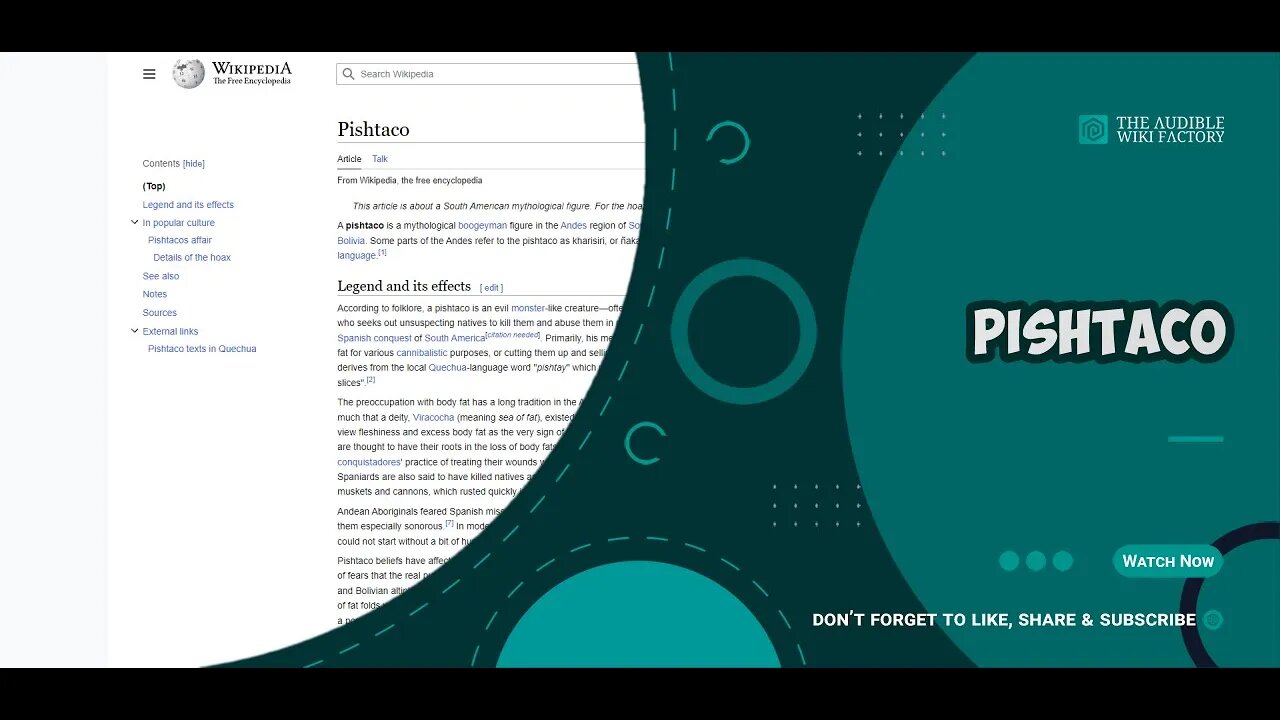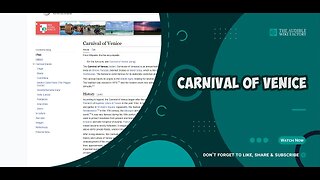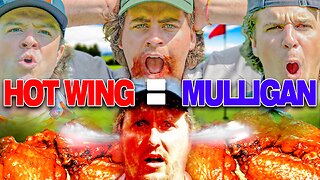Premium Only Content

A pishtaco is a mythological boogeyman figure in the Andes region of South America,
A pishtaco is a mythological boogeyman figure in the Andes region of South America, particularly in Peru and Bolivia. Some parts of the Andes refer to the pishtaco as kharisiri, or ñakaq, or lik'ichiri in the Aymara language.
LEGEND AND ITS EFFECTS
According to folklore, a pishtaco is an evil monster-like creature—often a stranger and often a white man—who seeks out unsuspecting natives to kill them and abuse them in many ways. The legend dates back to the Spanish conquest of South America. Primarily, his method of killing is stealing his victims' body fat for various cannibalistic purposes, or cutting them up and selling their flesh as fried chicharrones. Pishtaco derives from the local Quechua-language word "pishtay" which means to "behead, cut the throat, or cut into slices".
The preoccupation with body fat has a long tradition in the Andes region. Pre-Hispanic natives prized fat so much that a deity, Viracocha (meaning sea of fat), existed for it. It is also natural for the peasant rural poor to view fleshiness and excess body fat as the very sign of life, good health, strength and beauty. Many illnesses are thought to have their roots in the loss of body fats, and skeletal thinness is abhorred. With this, the conquistadores' practice of treating their wounds with their enemies' corpse fats horrified the natives. Spaniards are also said to have killed natives and boiled their corpses to produce fat to grease their metal muskets and cannons, which rusted quickly in the humid Amazon.
Andean Aboriginals feared Spanish missionaries as pishtacos, believing the missionaries were killing people for fat, thereafter oiling church bells to make them especially sonorous. In modern times, similar beliefs held that sugar mill machinery needed human fat as grease, or that jet aircraft engines could not start without a bit of human fat.
Pishtaco beliefs have affected international assistance programs, e.g. leading to rejection of the US Food for Peace program by several communities, out of fears that the real purpose was to fatten children and later exploit them for their fat. Natives have attacked survey geologists working on the Peruvian and Bolivian altiplano, because they believed that the geologists were pishtacos. The work of anthropologists has been stymied because measurements of fat folds were rumoured to be part of a plot to select the fattest individuals later to be targeted by pishtacos. In 2009, the pishtaco legend was cited as a possible contributory factor in the apparent fabrication of a story by Peruvian police of a gang murdering up to 60 people to harvest their fat.
IN POPULAR CULTURE
The pishtaco is prominently referenced in the novel Death in the Andes by Mario Vargas Llosa. In the book, two members of the Peruvian Civil Guard investigate the disappearance of three men, trying to determine if they were killed by the Shining Path guerilla group or by mythical monsters.
Pishtacos were primary plot source drivers and antagonists in the ninth season episode "The Purge" of the TV series Supernatural. This version of the Pishtaco have a lamprey-like appendage emitted from their mouth which feeds off fat. A human male marries a pishtaco female and the two start a weight-loss retreat so the female could sustain herself while helping those who wished to lose weight only for her brother to decide that he preferred killing those he fed from. A minor running gag was the near homophony of the word "pishtaco" with the phrase "fish taco". The male pishtaco is killed by Sam and Dean Winchester and the female pishtaco is given a one-way ticket back to Peru.
Pishtacos are also featured in the Gail Carriger novel Competence, the third book in her Custard Protocol series. The crew of the Spotted Custard travel to the...
LINK TO ARTICLE: http://en.wikipedia.org/wiki/Pishtaco
TAGS: Pishtaco, Bogeymen, Peruvian folklore, Race in Latin America, Peruvian culture, Aymara legendary creatures, Quechua legendary creatures, Multiracial affairs in South America, Cannibalism in South America
#GeneralKnowledge #AudibleWikiFactory #Audible #Wikipedia #Pishtaco
-
 13:12
13:12
The Audible Wiki Factory
2 years agoThe Carnival of Venice is an annual festival held in Venice, Italy. The carnival ends on Shrove
540 -
 8:14
8:14
MattMorseTV
5 hours ago $1.73 earnedTrump just DROPPED the HAMMER.
4.78K7 -
 LIVE
LIVE
Omar Elattar
5 hours agoThe $300M CEO: "The One Skill That Made Me Rich In 15 Different Countries!"
86 watching -
 1:06:12
1:06:12
BonginoReport
4 hours agoEric Swalwell Attempts To Look Manly in Desperate Stunt - Nightly Scroll w/ Hayley Caronia (Ep.101)
103K43 -
 LIVE
LIVE
SpartakusLIVE
2 hours agoTiger Blood RESTOCKED and 30% off w/ code SPARTAKUS30
125 watching -
 30:21
30:21
Friday Beers
4 hours ago $1.78 earnedOur Brutal Golf Challenge: Hot Wings Roulette
30.2K -
 2:58:40
2:58:40
Barry Cunningham
5 hours agoPRESIDENT TRUMP SPEECH AT MAKING HEALTH TECHNOLOGY GREAT AGAIN! EVENT AND MORE NEWS!
55.7K26 -
 3:17:42
3:17:42
ZeeroG
3 hours agoStarfield (E.P 4 ) 7/30/25
4.53K -
 1:00:08
1:00:08
The Officer Tatum
5 hours agoLIVE: Left CANCELS Their Own, All White Town, NYC Shooter Update + MORE | EP 146
30.8K27 -
 1:56:49
1:56:49
Julian Orbit
2 hours agoMy Friendly Neighborhood - First Look
1.79K